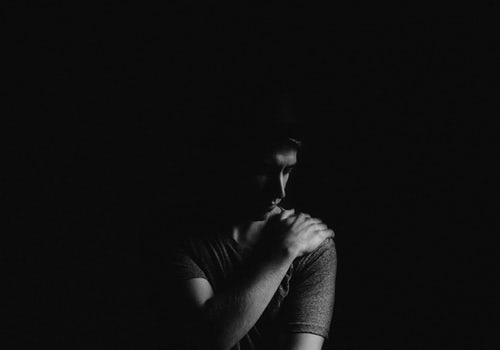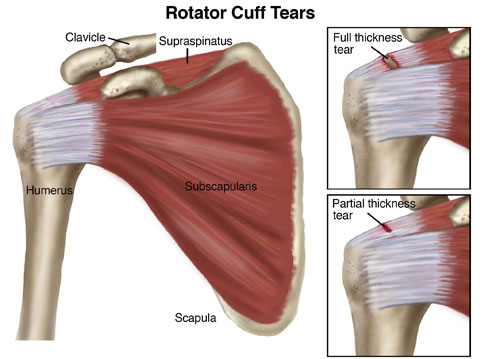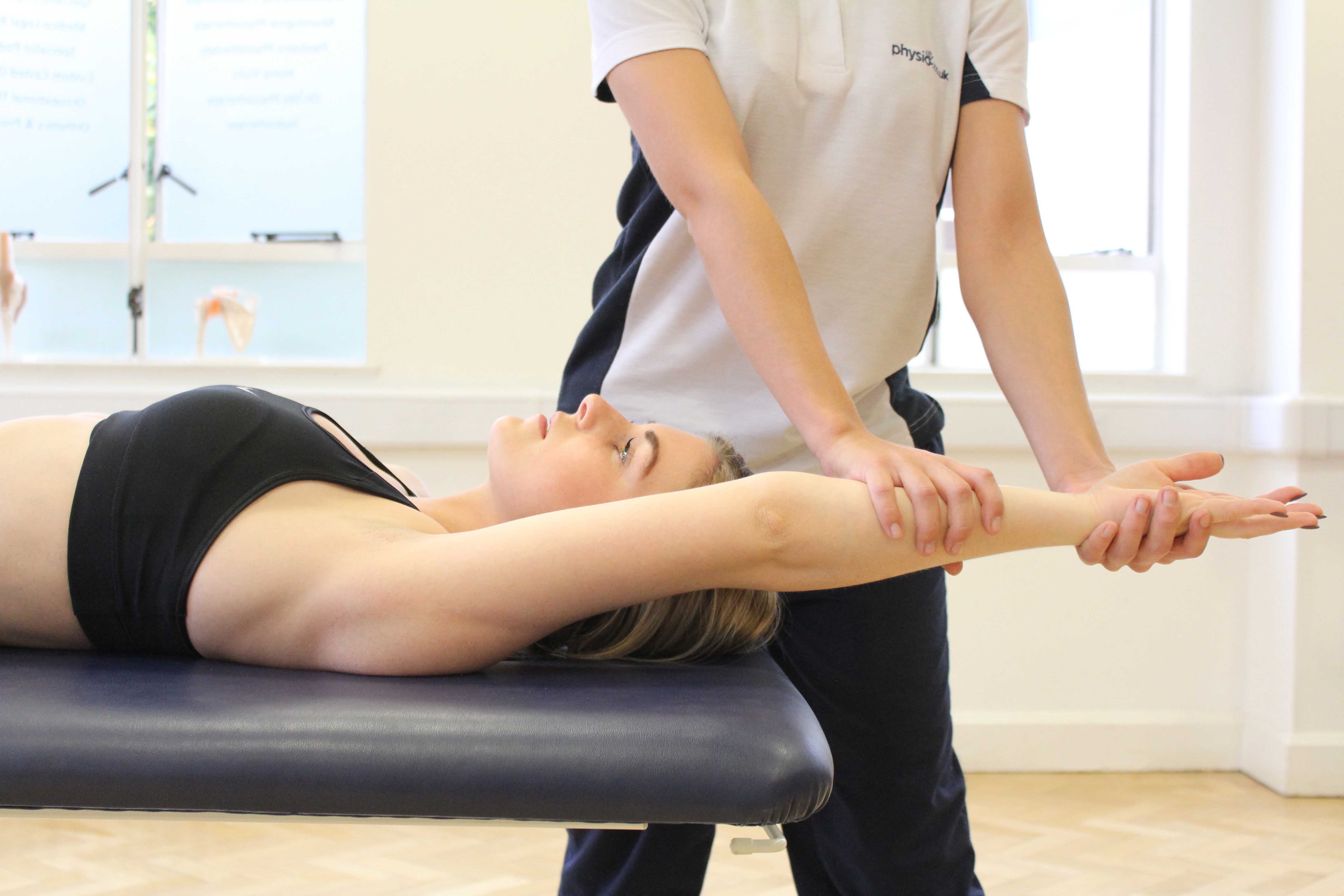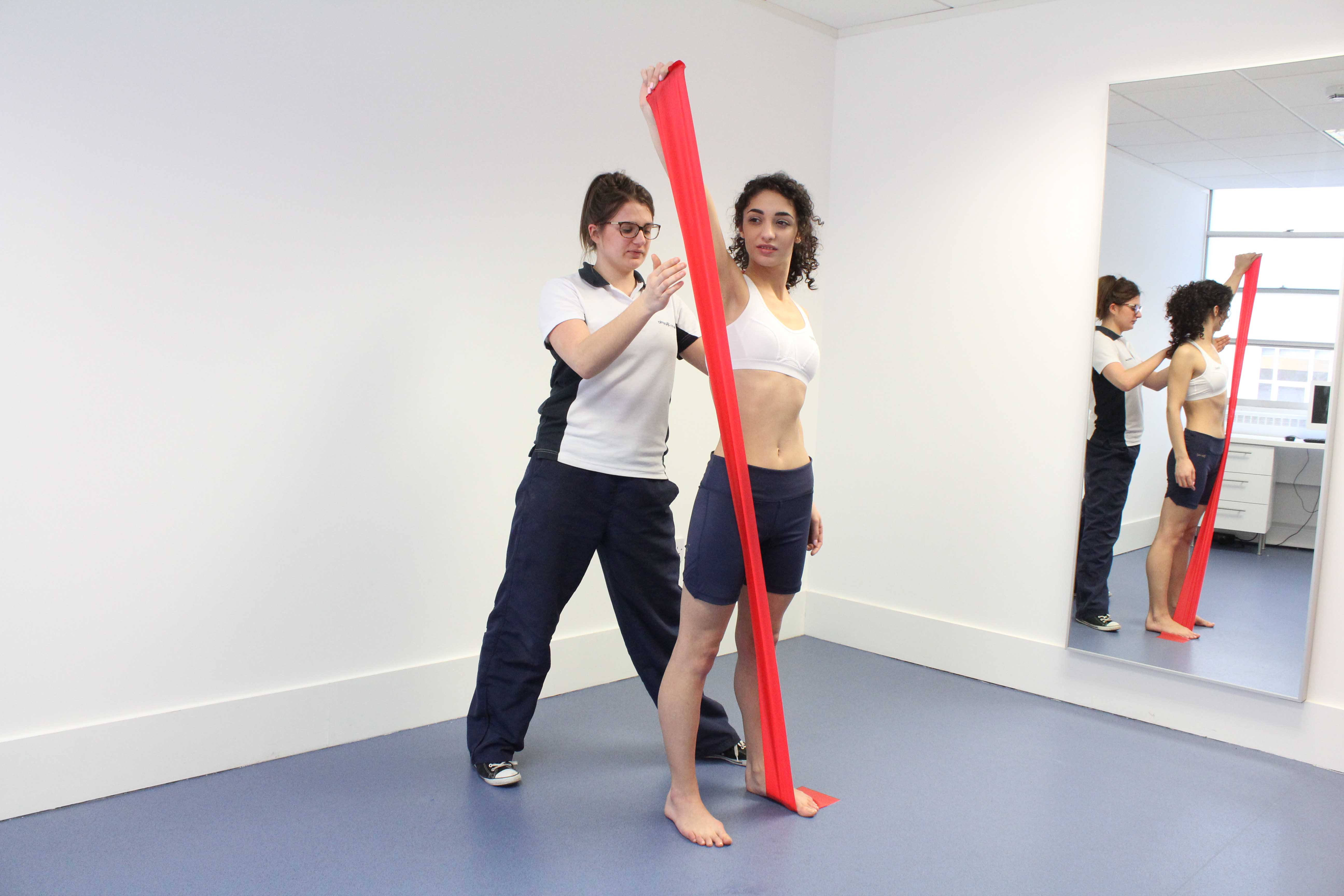|
BOOK NOW |
ASK ABOUT YOUR PAIN |
Home > Blog > Physiotherapy > Conditions > Shoulder Pain > Rotator Cuff Tear Physiotherapy
Rotator Cuff Tear Physiotherapy

Our "rotator cuff" muscles refers to a group of 4 muscles and their tendons responsible for keeping the shoulder joint stable.
...and unfortunately, injuries to the rotator cuff are pretty common—be it from accident or trauma, or with repeated overuse of the shoulder. Risk of injury can vary, but generally rate of shoulder injuries increases as a person ages.
Rotator cuff tears are more common later in life, but also can occur in younger people.
Athletes and heavy laborers often get shoulder injuries and shoulder pains - older adults can injure the rotator cuff when they fall on or strain the shoulder. When left untreated, a rotator cuff tear can cause severe pain and a decrease in the ability to use the arm.
Our senior physiotherapists help people with rotator cuff tears address
- shoulder pain
- shoulder joint stiffness
- restore movement to the shoulder and arm and
- improve their activities of daily living
What is a Rotator Cuff Tear?
The "rotator cuff" is a group of 4 muscles and their tendons (tissues that attach muscles to bones), which connects the upper arm bone (medically termed as humerus bone) to the shoulder blade.
The most important job of the rotator cuff is to keep the shoulder joint stable.
Sometimes, the rotator cuff becomes inflamed or irritated due to
- heavy lifting
- repetitive arm movements
- or trauma such as a fall
A rotator cuff tear occurs when injuries to the muscles or tendons cause tissue damage or disruption. Rotator cuff tears are called either "full thickness" or partial thickness," depending on how severe they are.
- Full-thickness tears extend from the top to the bottom of a rotator cuff muscle / tendon.
- Partial-thickness tears affect at least some portion of a rotator cuff muscle / tendon, but do not extend all the way through.
Tears often develop as a result of either a traumatic event or long-term overuse of the shoulder. These conditions are commonly called “acute” or “chronic.”
- Acute rotator cuff tears are those that occur suddenly, often due to traumas, such as a fall or lifting of a heavy object.
- Chronic rotator cuff tears are much slower to develop. These tears are often the result of repeated actions with the arms working above shoulder level, such as with ball-throwing sports or certain work activities.
People with chronic rotator cuff injuries often have a history of rotator cuff tendon irritation that causes shoulder pain with movement. This condition is known as shoulder impingement syndrome.
Rotator cuff tears also may occur in combination with injuries or irritation of the biceps tendon at the shoulder, or with labral tears (to the ring of cartilage at the shoulder joint). Our senior physiotherapist will explain to you more on the particular details of your rotator cuff tear.

How Does Rotator Cuff Tear Feel like?
People with rotator cuff tears can experience:
- Pain over the top of the shoulder or down the outside of the arm
- Shoulder weakness
- Loss of shoulder motion
- A feeling of weakness or heaviness in the arm
- Inability to lift the arm to reach up, or reach behind the back
- Inability to perform common daily activities due to pain and limited motion
How Is It Diagnosed?
To help pinpoint the cause of your shoulder pain, we will complete a thorough examination that will include
- learning details of your symptoms
- assessing your ability to move your arm
- identifying weakness and
- performing special tests that may indicate a rotator cuff tear
For instance, our senior physiotherapists may
- raise your arm
- move your arm out to the side or
- raise your arm and ask you to resist a force
all at specific angles of elevation.
In some cases, the results of these tests might indicate the need for a referral to an orthopedist or other professional for imaging tests, such as
- ultrasound imaging
- magnetic resonance imaging (MRI) or
- a computed tomography (CT) scan
how our senior physiotherapists can help you

Once a rotator cuff tear has been diagnosed, you will work with your orthopedist and our senior physical therapists to decide if you should have surgery or if you can try to manage your recovery without surgery.
If you prefer not to have surgery or don't need surgery, we will work with you to restore your
- range of motion
- muscle strength
- and coordination
so that you can return to your regular activities. In some cases, you may learn to modify your physical activity so that you put less stress on your shoulder.
If you decide to have surgery, we can help you both before and after the procedure (post-surgical physiotherapy).
Regardless of which treatment you have—physical therapy only, or surgery and physical therapy—early treatment can help you speed the healing process and avoid permanent damage
If You Have an Acute Shoulder Injury
If a rotator cuff tear is suspected following a trauma, seek the attention of our senior physiotherapists or doctor to rule out the possibility of serious life- or limb-threatening conditions.
Once serious injury is ruled out, we will help you manage your pain and will prepare you for the best course of treatment.
If You Have a Chronic Shoulder Injury
We can help manage the symptoms of chronic rotator cuff tears as well as improve how your shoulder works.
For large rotator cuff tears that can't be fully repaired, we can teach special strategies to improve shoulder movement. However, if physical therapy and conservative treatment alone do not improve your function, surgical options may exist.
If You Had Corrective Shoulder Surgery
If your condition is severe, you may require surgery to restore use of the shoulder; shoulder physiotherapy will be an important part of your recovery process. The repaired rotator cuff is vulnerable to reinjury following shoulder surgery; working with a us will be vital to safely regaining full use of the injured arm.
After the surgical repair, you will need to wear a sling to keep your shoulder and arm protected as the repair heals.
We will apply treatments during this phase of your recovery to reduce pain and gently begin to restore movement. Once you are able to remove the sling for exercise, we will begin your full rehabilitation program.
We will design a treatment program based on both the findings of the evaluation and your personal goals. We will guide you through your postsurgical rehabilitation, which will progress from gentle range-of-motion and strengthening exercises to activity- or sport-specific exercises.
Your shoulder physiotherapy treatment program most likely will include a combination of exercises to strengthen the rotator cuff and other muscles that support the shoulder joint.
A lot of patients ask this, and the general time line for your recovery will vary depending on the surgical procedure and your general state of health, but
- return to sports
- heavy lifting
- and other strenuous activities
might not begin until 4 months after surgery and full return may not occur until 9 months to 1 year after surgery.

Please note that after a corrective shoulder surgery, your shoulder will be susceptible to reinjury. It is extremely important to follow the postoperative instructions provided by your surgeon and physical therapist.
Your shoulder physiotherapy program will typically be divided into 4 phases:
Phase I (maximal protection)
Phase 1 of treatment lasts for the first few weeks after your surgery, when your shoulder is at the greatest risk of reinjury. During this phase, your arm will be in a sling. You will likely need assistance or need strategies to accomplish everyday tasks, such as
- bathing
- brushing teeth
- dressing
- etc
We will teach you gentle range-of-motion and isometric strengthening exercises, provide hands-on treatments (manual therapy), such as gentle massage, offer advice on reducing your pain, and may use techniques such as cold therapy and electrical stimulation to relieve pain.
Phase II (moderate protection)
This next phase has the goal of restoring mobility to the shoulder. You will reduce the use of your sling, and your range-of-motion and strengthening exercises will become more challenging.
Exercises will be added to strengthen the "core" muscles of your trunk and shoulder blade (scapula), and the rotator-cuff muscles that provide additional support and stability to your shoulder.
You will be able to begin using your arm for daily activities, but will still avoid heavy lifting. We may use special hands-on mobilization techniques during this phase to help restore your shoulder's range of motion.
Phase III (return to activity)
This phase has the goal of restoring your strength and joint awareness to equal that of your other shoulder. At this point, you should have full use of your arm for daily activities, but you will still be unable to participate in activities such as sports, yard work, or physically strenuous work-related tasks.
We will advance the difficulty of your exercises by adding weight or by having you use more challenging movement patterns. A modified weight-lifting/gym-based program may also be started during this phase.
Phase IV (return to occupation/sport)
This phase will help you return to work, sports, and other higher-level activities. During this phase, we will instruct you in activity-specific exercises to meet your needs. For certain athletes, this may include throwing and catching drills.
For others, it may include practice in lifting heavier items onto shelves, or instruction in proper positioning for everyday tasks such as raking, shoveling, or doing housework.